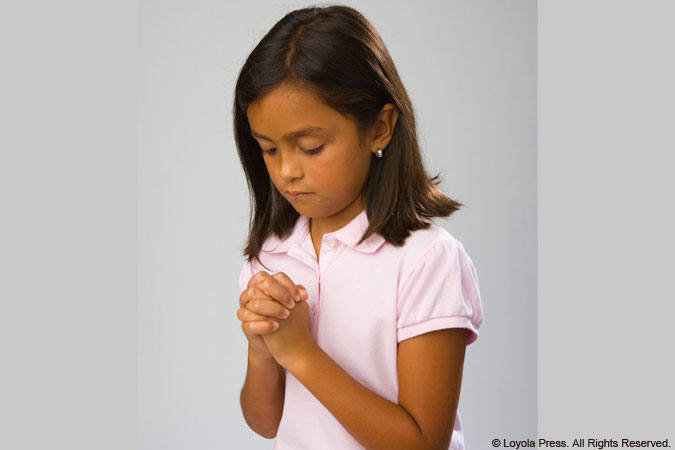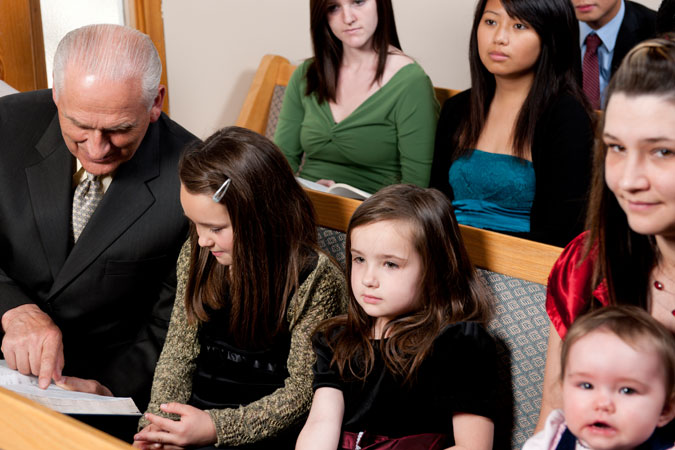
The longer I am a catechist, the more I feel the need to focus on prayer with the children in my classes. For so long I limited prayer to the start and end of class, and I encouraged the children to memorize traditional prayers. But I didn’t do much else. Now I lead the children in exploring new and varied ways to pray so they can grow in their personal relationship with God.
Early in the year, I focus an entire class on prayer. We sit in a circle on the carpet, and I ask the the following questions: What is prayer? Why do we pray? When and where we can pray? The answers range from a bit comical (“Prayer is like saying some stuff we know to God.”) to beautiful (“We pray because we love God.”). One thing the children do seem quite sure about is that they can pray anytime and anywhere. It’s always fun to see how many examples they can come up with. We can have a wide-ranging discussion about what we can pray for—I was told today that we can’t pray for money. I never know where a discussion will go. I get varied (and sometimes humorous) responses when I ask what Amen means. As you might guess, the most common answer is that it means “the end.”
Throughout the year I introduce many kinds of prayer. At the end of each session, we pray an Act of Contrition and a Hail Mary. We gather around our classroom prayer table, and I ask the children if there is anyone they would like us to pray for. I model these intercessions by offering my own petitions. Some weeks I will have prompts to help, such as, “What do you want to thank God for today?” As part of our All Saints celebration, I create a Litany of Saints based on the names of each of the children. Many of them are surprised to know they share a name with a saint. We respond by singing “Pray for us,” so that they experience another kind of prayer. I include music in other ways during the year. We sing hymns or simple children’s faith songs, and I play reflective music in the background when we pray. One very popular prayer prompt is our class Prayer Bear—a teddy bear that each child has an opportunity to take home for a week. The Prayer Bear includes a notebook with suggestions for different ways to pray and pages for journaling how the children prayed with him.
By far, my favorite experience of prayer with my class is guided reflections. You might be surprised at how quiet and prayerful second graders can be when listening for God! I first tried these when I bought Guided Reflections for Children: Praying with Scripture on a whim. Now not only do I rely on that (and its companion book) but also am lucky to have guided reflections as part of our Reconciliation and Eucharist sacrament textbooks. Children love to use their imaginations, and there is nothing better than imagining visiting with Jesus! Today my aide and I were astonished that a student who is invariably disruptive throughout class was still and silent for the entire reflection. This is an example of the power of prayer.
Of course, I always stress the importance of our traditional Catholic prayers such as the Lord’s Prayer and the Hail Mary. Starting our first week with the Sign of the Cross, I focus on one traditional prayer every week. Beyond just memorizing these prayers, I want the children to understand what the prayers mean. For that, we go over the prayers phrase-by-phrase. I have a series of cards, each with one phrase of the prayer. I hand out the cards to the students, they read their phrases in turn, and we discuss what the phrases mean. We then repeat the prayer from the beginning until we get to the next phrase to be added. In the Lord’s Prayer, the meaning of many of the words, such as art, hallowed, thy, and will, are unknown to my second graders. A few children have some idea of what the words heaven, trespass, and temptation mean. We define any unfamiliar words before we even look at the meaning of the phrases.
These are some of the ways I pray with my second graders. How do you pray with your class? How do you encourage your class to pray?





Beautiful
Thank you for sharing.I will apply this to my little children’s class.